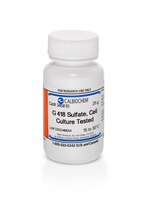345810 MilliporeG 418 Sulfate, Cell Culture Tested - CAS 108321-42-2 - Calbiochem
G418 also known as Geneticin® is an aminoglycoside antibiotic related to Gentamicin. Used as a selective agent in transfection of eukaryotic cells. Has highest potency ≥730 µg/mg and purity ≥98%.
More>> G418 also known as Geneticin® is an aminoglycoside antibiotic related to Gentamicin. Used as a selective agent in transfection of eukaryotic cells. Has highest potency ≥730 µg/mg and purity ≥98%. Less<<Synonyms: NMD Inhibitor I, G418, G 418
Recommended Products
Overview
| Replacement Information |
|---|
Key Spec Table
| CAS # | Empirical Formula |
|---|---|
| 108321-42-2 | C₂₀H₄₀N₄O₁₀ · 2H₂SO₄ |
| Description | |
|---|---|
| Overview | Aminoglycoside related to gentamycin that inhibits prokaryotic and eukaryotic protein synthesis. Toxic to bacteria, yeast, protozoans, helminths, higher plant, and mammalian cells. Widely used in the selection of eukaryotic expression vectors carrying the bacterial neor/kanr genes. The product of these genes, aminoglycoside 3′-phosphotransferase, inactivates G418, neomycin, and kanamycin by phosphorylation. Introduction of either of these genes into cells can confer resistance to G418, which enables cells to grow in media containing G418. |
| Also available as a sterile-filtered aqueous solution (Cat. No. 345812), a sterile filtered solution in 100 mM HEPES (Cat. No. 508940), and a sterile-filtered solution PBS (Cat. No. 509227). | |
| Catalogue Number | 345810 |
| Brand Family | Calbiochem® |
| Synonyms | NMD Inhibitor I, G418, G 418 |
| Product Information | |
|---|---|
| CAS number | 108321-42-2 |
| Form | White powder |
| Hill Formula | C₂₀H₄₀N₄O₁₀ · 2H₂SO₄ |
| Chemical formula | C₂₀H₄₀N₄O₁₀ · 2H₂SO₄ |
| Structure formula Image | |
| Quality Level | MQ100 |
| Applications |
|---|
| Biological Information | |
|---|---|
| Biological activity | Assay: ≥730 µg/mg |
| Purity | ≥98% by TLC |
| Physicochemical Information | |
|---|---|
| Contaminants | Ammonia: ≤1.0%; heavy metals: ≤100 ppm |
| Dimensions |
|---|
| Materials Information |
|---|
| Toxicological Information |
|---|
| Safety Information according to GHS | |
|---|---|
| RTECS | CB9378500 |
| Safety Information |
|---|
| Product Usage Statements |
|---|
| Packaging Information |
|---|
| Transport Information |
|---|
| Supplemental Information |
|---|
| Specifications |
|---|
| Global Trade Item Number | |
|---|---|
| Catalogue Number | GTIN |
| 345810 | 0 |
Documentation
G 418 Sulfate, Cell Culture Tested - CAS 108321-42-2 - Calbiochem SDS
| Title |
|---|
G 418 Sulfate, Cell Culture Tested - CAS 108321-42-2 - Calbiochem Certificates of Analysis
| Title | Lot Number |
|---|---|
| 345810 |
References
| Reference overview |
|---|
| Ethier, S.P., and Taback, E. 1993. Cancer Lett. 74, 189. Santerre, R.F., et al. 1991. Methods Mol. Biol. 7, 245. Maniatis, T., et al. 1989. In Molecular Cloning, A Laboratory Manual, Second Edition, Cold Spring Harbor, NY. Edwards, S.A., and Adamson, E.D. 1987. J. Cell Physiol. 133, 46. Ernst, J.F., and Chan, R.K. 1985. J. Bacteriol. 163, 8. Canaani, D., and Berg, P. 1982. Proc. Natl. Acad. Sci. USA 79, 5166. Hirth, K.P., et al. 1982. Proc. Natl. Acad. Sci. USA 79, 7356. Ursic, D., et al. 1981. Biochem. Biophys. Res. Commun. 101, 1031. Jimenez, A., and Davies, J. 1980. Nature 287, 869. |
Brochure
| Title |
|---|
| Antibiotics Profiler |
| Bulk Product Guide |
| The Complete Molecular Biology Toolkit - Expert workflow solutions from DNA cloning to protein expression |
Citations
| Title | |
|---|---|
|
|
| Data Sheet | ||||||||||||||||||||||||||||||||||||||
|---|---|---|---|---|---|---|---|---|---|---|---|---|---|---|---|---|---|---|---|---|---|---|---|---|---|---|---|---|---|---|---|---|---|---|---|---|---|---|
|
Note that this data sheet is not lot-specific and is representative of the current specifications for this product. Please consult the vial label and the certificate of analysis for information on specific lots. Also note that shipping conditions may differ from storage conditions.
|













 Antibody[198945-ALL].jpg)

